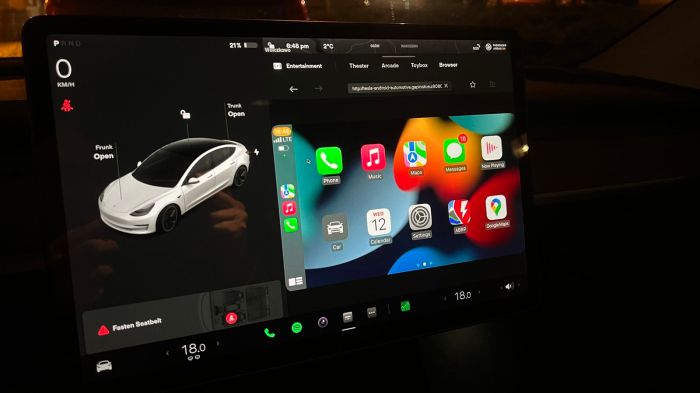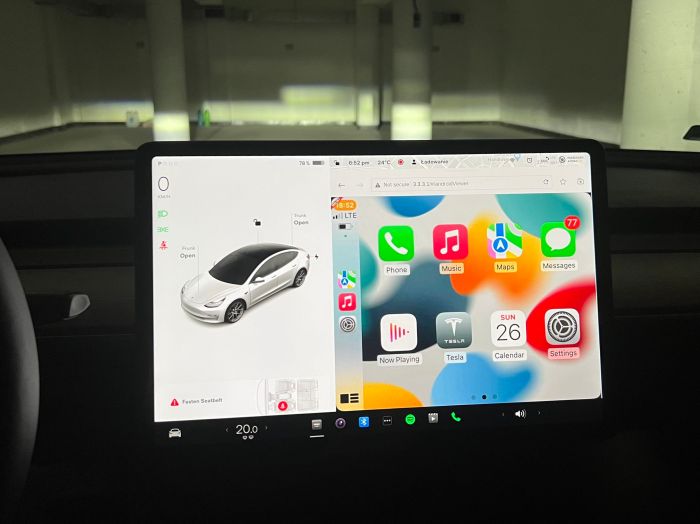Tesla’s Stance on CarPlay Integration
Tesla’s approach to integrating with Apple CarPlay remains a point of contention for many drivers who are accustomed to the convenience and familiarity of the CarPlay ecosystem. While Tesla has its own in-car infotainment system, known for its sleek interface and advanced features, the lack of CarPlay integration has sparked curiosity and speculation.
Historical Context of Tesla’s CarPlay Integration
The history of Tesla’s CarPlay integration is marked by silence and speculation. While Tesla has never officially stated its stance on CarPlay, there have been various instances that suggest a deliberate decision to avoid integrating the platform. The company has always maintained its own proprietary infotainment system, emphasizing its unique design and functionality. This approach aligns with Tesla’s commitment to creating a tightly integrated user experience within its vehicles, where everything is seamlessly connected and controlled through the Tesla touchscreen.
The Impact of Tesla’s Decision on Consumers
Tesla’s decision to not integrate CarPlay into its vehicles has sparked debate, with both potential benefits and drawbacks for consumers. While Tesla touts its in-house infotainment system as superior, the lack of CarPlay compatibility raises concerns about user experience, accessibility, and the potential impact on Tesla’s brand image.
User Experience and CarPlay Integration
The user experience of Tesla’s infotainment system, while innovative, is not without its shortcomings. While it boasts features like a large touchscreen, over-the-air updates, and seamless integration with Tesla’s ecosystem, some users find the interface cumbersome and lack the familiarity of CarPlay. CarPlay, on the other hand, offers a standardized and intuitive interface, compatible with a wide range of apps and services.
The Implications for CarPlay Users
For consumers accustomed to CarPlay’s ease of use and familiar app ecosystem, Tesla’s decision poses a significant challenge. They may find themselves unable to access their preferred navigation apps, music streaming services, or voice assistants within their Tesla. This could lead to a less seamless and enjoyable driving experience, especially for those who rely heavily on CarPlay features.
Tesla’s decision could potentially impact its brand image and market share. While some consumers may appreciate the company’s commitment to its own ecosystem, others may view the lack of CarPlay compatibility as a sign of inflexibility or a limitation. This could deter potential buyers who prioritize seamless integration with their existing devices and apps, potentially affecting Tesla’s sales and market share in the long run.
The Competitive Landscape of In-Car Infotainment Systems: Tesla Keeping Mum On Involvement With Apples Carplay
The in-car infotainment system market is becoming increasingly competitive, with a wide range of options available from various car manufacturers. Tesla has carved its own niche with its unique approach to infotainment, but it faces competition from established players like Apple CarPlay, Android Auto, and other car manufacturers’ proprietary systems.
Comparison of Tesla’s Infotainment System with Other Leading Car Manufacturers
Tesla’s infotainment system is known for its large touchscreen interface, which controls almost every aspect of the car, from climate control to navigation. It also boasts a powerful processor and a wide range of apps, including streaming services and games. While Tesla’s system offers a unique and user-friendly experience, it also has its drawbacks. The reliance on a single touchscreen can be cumbersome for some tasks, and the lack of physical buttons can make it difficult to use while driving.
Other leading car manufacturers, such as BMW, Mercedes-Benz, and Audi, have their own proprietary infotainment systems. These systems often offer a more traditional approach with physical buttons and knobs alongside touchscreen interfaces. While they may not be as visually appealing or feature-rich as Tesla’s system, they are generally considered more user-friendly and less distracting while driving.
Trends in In-Car Infotainment Technology, Tesla keeping mum on involvement with apples carplay
The in-car infotainment landscape is constantly evolving, with new technologies and features emerging regularly. Some of the current trends include:
- Voice control: Voice assistants like Amazon Alexa and Google Assistant are becoming increasingly integrated into car infotainment systems, allowing drivers to control various functions with their voice. This hands-free functionality enhances safety and convenience.
- Over-the-air updates: Car manufacturers are increasingly using over-the-air updates to deliver new features and bug fixes to their infotainment systems. This allows them to continuously improve the user experience and add new functionality without requiring physical visits to dealerships.
- Augmented reality (AR) navigation: AR navigation overlays real-time information, such as turn-by-turn directions, onto the driver’s view of the road. This technology can enhance safety and make navigation more intuitive.
- Advanced driver-assistance systems (ADAS): ADAS features, such as lane departure warning, adaptive cruise control, and automatic emergency braking, are becoming increasingly integrated into infotainment systems. These systems can enhance safety and make driving more comfortable.
Features and Functionalities of CarPlay and Other Systems
Apple CarPlay and Android Auto are popular smartphone mirroring systems that allow users to access their phone’s apps and features on their car’s infotainment screen. These systems offer a wide range of functionalities, including:
- Navigation: Users can access their preferred navigation apps, such as Google Maps or Waze, through CarPlay and Android Auto. This allows for easy navigation and real-time traffic updates.
- Music streaming: Users can listen to their favorite music streaming services, such as Spotify, Apple Music, and Pandora, through CarPlay and Android Auto. This allows for a seamless and personalized listening experience.
- Phone calls and messaging: Users can make and receive phone calls and send and receive messages through CarPlay and Android Auto. This allows for safe and convenient communication while driving.
- Other apps: CarPlay and Android Auto support a variety of other apps, including podcasts, audiobooks, and weather apps. This allows for a wide range of entertainment and information options while driving.
The Future of In-Car Infotainment Systems
The future of in-car infotainment systems is likely to be characterized by further integration with smartphones and the increasing adoption of advanced technologies.
“The future of in-car infotainment is about seamlessly integrating the smartphone experience into the car, while also offering features that enhance safety and convenience.”
We can expect to see more features like voice control, augmented reality, and advanced driver-assistance systems become commonplace. As cars become more connected, the lines between the car and the smartphone will continue to blur, creating a more personalized and immersive driving experience.
The Potential for Future Integration
While Tesla has been steadfast in its refusal to embrace CarPlay, the possibility of future integration remains a topic of speculation. It’s a question that stirs curiosity among Tesla owners and enthusiasts alike, pondering the potential benefits and challenges of merging the two systems.
Factors Influencing Integration
The decision to integrate CarPlay into Tesla vehicles is ultimately in the hands of Elon Musk and the Tesla team. Several factors could influence their stance on this matter.
- Market Pressure: As the demand for CarPlay integration grows, Tesla might feel pressure to comply with consumer expectations. If a significant portion of potential Tesla buyers prioritize CarPlay compatibility, it could become a crucial factor in their decision-making process.
- Competitive Landscape: Tesla’s competitors, like BMW, Audi, and Mercedes-Benz, are already embracing CarPlay integration. If Tesla continues to resist, it could fall behind in terms of in-car infotainment features, potentially impacting its market share.
- Technological Advancements: The evolution of CarPlay technology could lead to more compelling features and functionalities. If CarPlay evolves to offer a more seamless and integrated experience, Tesla might find it more appealing to adopt.
- User Experience: The integration of CarPlay could improve the user experience for Tesla owners, particularly those who rely on Apple devices. A unified interface could offer a more streamlined and intuitive experience, potentially leading to increased customer satisfaction.
Potential Benefits and Challenges
The integration of CarPlay into Tesla vehicles presents both potential benefits and challenges.
- Enhanced Functionality: CarPlay offers a wide range of features and apps, including navigation, music streaming, messaging, and more. Integrating CarPlay could expand Tesla’s in-car infotainment system, providing users with a more comprehensive and versatile experience.
- Improved User Experience: For Apple users, CarPlay offers a familiar and intuitive interface, seamlessly integrating with their iOS devices. This could enhance the overall user experience, particularly for those who are accustomed to Apple’s ecosystem.
- Increased Convenience: CarPlay allows for hands-free control of various functions, enhancing safety and convenience while driving. Tesla owners could benefit from features like voice commands, Siri integration, and the ability to access their apps without taking their hands off the wheel.
- Potential Challenges: Integrating CarPlay into Tesla’s existing infotainment system could pose challenges. The two systems might require extensive adjustments to ensure seamless integration and functionality. Moreover, Tesla might face resistance from users who prefer its current system or are concerned about the impact on performance.
Hypothetical Timeline
While there’s no official word from Tesla about CarPlay integration, it’s possible to speculate on a potential timeline.
- Short-Term (Next 1-2 Years): It’s unlikely that Tesla will embrace CarPlay in the immediate future. The company has consistently prioritized its own infotainment system, and it might take a significant shift in market dynamics or consumer demand to change its stance.
- Mid-Term (3-5 Years): As the demand for CarPlay integration continues to grow and competitors adopt the technology, Tesla might consider integrating CarPlay in future model updates or revisions. However, it’s important to note that Tesla has a history of prioritizing its own innovations and might resist adopting a third-party solution.
- Long-Term (5+ Years): In the long term, Tesla might eventually embrace CarPlay integration, especially if the technology evolves significantly or becomes a standard feature across the automotive industry. However, it’s difficult to predict with certainty, as Tesla’s future decisions are ultimately driven by its own vision and strategy.
Tesla keeping mum on involvement with apples carplay – The silence surrounding Tesla and CarPlay remains a mystery. While Tesla continues to innovate and push the boundaries of in-car technology, the lack of CarPlay integration raises questions about the future of their infotainment strategy. Whether Tesla eventually decides to embrace CarPlay or continues to chart its own course, the debate over the benefits and drawbacks of this decision will likely continue. One thing is certain: the future of in-car infotainment is rapidly evolving, and Tesla’s role in this landscape will be one to watch closely.
Tesla’s silence on CarPlay integration is a bit of a head-scratcher, especially considering the growing popularity of immersive technologies like virtual reality. Imagine browsing through potential Airbnb stays in cities like Paris or Tokyo, virtually exploring the space and its surroundings, thanks to VR technology like Airbnb VR Preview Rooms. Maybe Tesla is playing the long game, waiting for the perfect moment to unleash its own integrated experience that goes beyond CarPlay’s limitations.
 Standi Techno News
Standi Techno News

